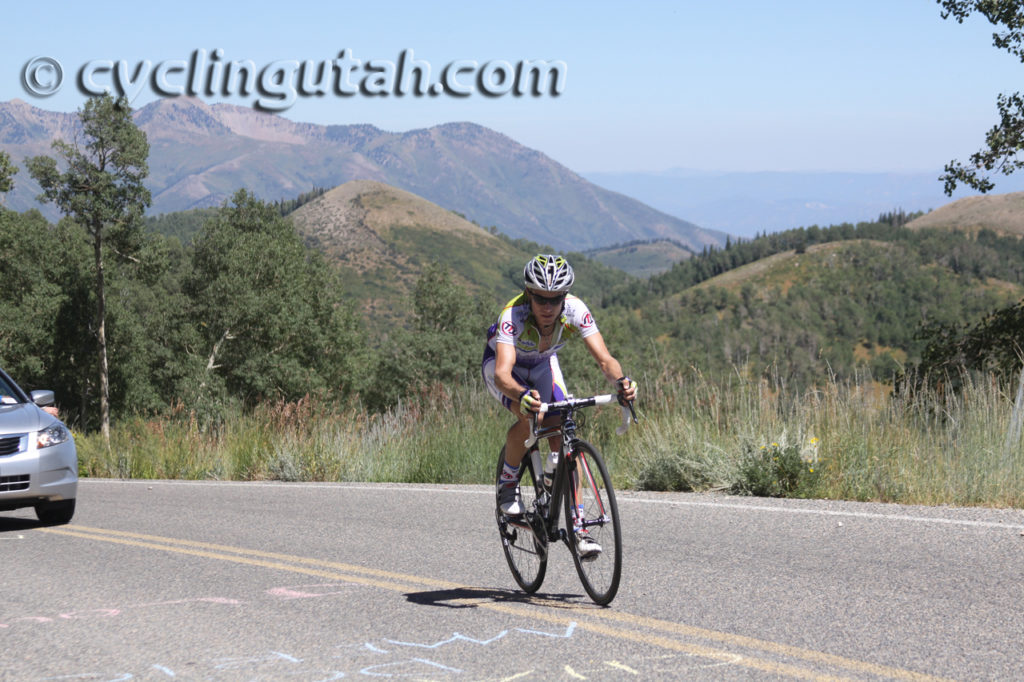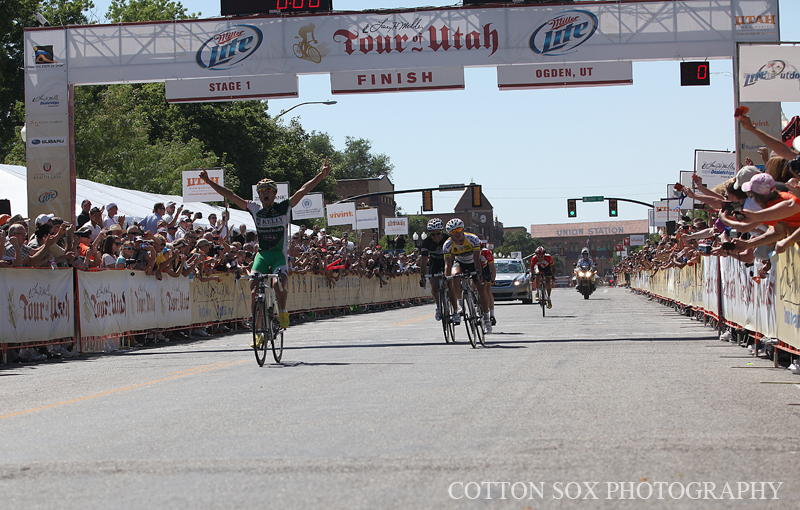Bicycle Stage Race Strategy
By Greg Overton
IT’S A TEAM THING
It’s not obvious to the casual or novice observer, but bicycle racing, especially in stage races such as the Tour of Utah, is very much a team sport and a very cerebral sport that involves constant attention to tactics and strategy. In fact, it’s very rare for a rider to be victorious without the support of a strong team. Even with regard to the legends of the sport, from Coppi and Anquetil, to Merckx, Hinault and LeMond, victory only came in the Grand Tours when they had strong teams to support them. Lance Armstrong’s Tour de France teams were widely hailed as the strongest in the field, and Armstrong often credited his team as the reason he was victorious in his seven Tour triumphs. Race tactics are often built around the team members and their particular strengths as they apply to each stage.


A professional cycling team can include twenty- five or more riders depending upon its budget and the number of events that the team chooses to contest during the season. At times, there may be races scheduled simultaneously and far apart, and the team must divide its members to assemble a group that it feels will have the best chance for success in each event. Larger, more prestigious races are given highest priority, but even in those cases, the race’s terrain, the competing teams and each rider’s fitness level at the lime must be factored into who is chosen to compete
Most stage races will specify that each team enter a group of eight to twelve riders. The directors of the team must decide which combination of its riders will provide the best chance for victory. This may precipitate the appointment of a team leader for the race, and the remainder of the teammates are selected with regard to their abilities to assist that leader to the overall win. At times, this structure means that strong riders are left out of the final team selection. For instance, a team leader who is very strong in circuit or criterium races (multiple lap events usually contested on relatively flat courses) may not be selected for a race like the Tour of Utah, which has several very hard mountain climbs. Or more likely, the team will bring its leader to the race, but will relegate him to the role of super domestique in support of a stronger-climbing team member.
Teams with little chance for overall victory in a stage race may treat the event as a group of one-day races and appoint a leader for each day’s course based upon the particular rider’s abilities in that stage. On flatter stages, the climbers on the team may be directed to work for the sprinters, only to have the roles reversed on the mountain stages. These teams are racing for daily stage wins, with no real priority placed on the overall victory for a single member of the team.
“Ninety percent of this game is mental, the other half is physical” Yogi Berra
It’s a rolling chess match each day. Lets say that a team decides to go for the stage win on a particular day, and the course is hilly and long. Early in the stage, the director may order a rider who is more suited to a different type of terrain or distance to make an attack. This places the other teams in a defensive posture. Should they send riders up the road to chase the attacker, or will he falter along the course? If the opposing teams choose not to chase, and the attacking rider remains away for the entire day, they’ve given the lead to an opponent. If they choose to chase the attacker, they risk pulling his teammates along, allowing them to conserve energy. Once the attack is caught, one of the attacker’s teammates, still relatively fresh from riding in the protection of the pack, is sure to launch his own counter attack. Now the decision process begins anew for the rival teams in the peloton. This method may be carried out several times in a single stage as riders attack in succession, forcing the other teams to use precious energy chasing, or “covering” the attacks. All of this is done with the goal of delivering your strongest rider on the day to the finish line; or near it, in a fresh state compared to the other contenders. The leader has been protected and can now contest a sprint finish or perhaps even launch a late attack for the win, with an advantage over his rivals who are fatigued from the effort of repeated chases throughout the day.
Some riders may be ordered to simply cover every attack throughout a race. They may sacrifice their own chances by using their energy in order to cover attacks from the other teams, ensuring that no rivals get away for an uncontested victory. Another reason to send teammates out ahead is to have them along the road should the peloton accelerate or if perhaps a small group breaks away. The team with the most riders present in any group usually has an advantage, so ‘picking up” riders during the race becomes the payoff to having them chase attacks or participate in them early, often having them available later to protect the team leader as the race approaches the finish.
Occasionally an attack is purely a bluff. A rider may put in a very hard attack, causing rivals to react and chase or participate in the break, using valuable energy while under the impression that everyone in the group is willing to work hard for a successful breakaway and a chance at the stage win. Suddenly the instigator of the attack may ‘sit up’ and stop working, having fulfilled his mission of tiring riders from the other teams or drawing out the chasers in order to expose a rival’s strategy for that day. This is always a factor in the decision whether to chase a particular attacker or not. An experienced and savvy rider or team manager will be knowledgeable of his opponents in order to better determine which breaks to follow and which rivals are capable to make the break succeed. It’s a terrible miscue for a team to miss a decisive break, or to have no riders in a strong break because those teams are now forced to chase the breakaway, again expending the cyclists most valuable currency — energy.
The enemy of my enemy is my friend.
Why work with your opponents in the breakaway? The answer is simple. There is strength in numbers, or more accurately, there is speed in numbers. A single rider usually has a very small chance of succeeding in a solo breakaway. The workload on a single rider pedaling into the wind is about 30% greater than that of a rider drafting behind another. With more than one rider in a breakaway, the workload can be shared as the riders alternate ‘taking pulls’ at the front, allowing the others in the breakaway group to conserve energy by drafting. This advantage increases with more riders in the group. The reason behind working with an opponent in a breakaway is self preservation; ensuring that you will arrive at the finish as strong as possible. Your opponent will also arrive as strong as possible, so the chance for victory is greater for each rider On the other hand, riders who do not work together use much more energy, and are usually caught by the peloton, losing any chance for victory.
Another important strategy employed by teams who have a rider in a breakaway is blocking. Often, a team that has a strong rider up the road will assemble at or near the front of the peloton and deliberately ride at a slower pace than normal with the intention of disrupting the field’s coherence and speed, giving the breakaway a larger time gap, or lead, on the chasing group. Opposing riders must negotiate around the blocking riders to increase the speed of the chase. This can happen over and over throughout portions of the stage, resulting in a bit of disarray and inefficient energy usage, causing the speed to fluctuate as chasers accelerate and blockers decelerate. All of this benefits the breakaway riders.
So, how do teams prevent rivals from attacking? Strong teams will ‘ride tempo’ or set a fast pace at the front of the peloton by sending several of its riders to the head of the group. These riders will work almost like a small breakaway, alternating pulls at the front to remain as strong as possible, while setting a very fast pace to discourage anyone from instigating an attack, or actually setting such a fast pace to make it impossible for one rider to accelerate from the group. Riding tempo is often done to bring the peloton near the finish line in tact. This protects the sprinters from late attacks so they can initiate their sprints and contest for the win. A team will also ride tempo at times to bring its climbers to the bottom of a climb with no breakaway ahead that would force them to chase on the mountain.
All of this chasing, attacking and tempo riding is usually done by the team’s designated domestiques, or servants. A domestique may be asked to absolutely spend himself during a race by doing whatever is required to offer his team leader the best chance for victory. This duty may find a domestique in front of the field in a breakaway, sometimes even winning a stage one day, but the next day he may be deliberately falling behind the peloton to ride alongside the team car in order to pick up food and drinks for teammates in the group. The team crew riding in the car will hand as much food and as many water bottles as possible to the domestique, who will carry the bottles in his jersey pockets and stuffed inside his jersey, wherever possible until be has enough for the team. Then he must accelerate up to the peloton ahead and work his way through the pack, handing food and bottles to his mates. Many times a domestique will be directed to ride alongside or in front of the team leader in order to protect him from the wind, or any mishaps or time loss from mechanical issues. Should the leader suffer a puncture or mechanical issue, the domestique will give him his own wheel, sometimes his entire bike, so the leader does not have to wait for the team car and lose valuable time. The domestique will wait for the team car with the damaged wheel or bike, only to have to chase back into the group and resume his role once given his replacement.
This rolling chess match is compounded by the fact that each team in the race is plotting and strategizing to implement these tactics, and the foundation of it all for team managers is to remain flexible. The day’s plan may change completely if a particular team has planned to launch an attack at the 50 mile mark for instance, only to have another team launch its own attack at the 45 mile mark. Now, it’s time for Plan B, or C, or D. As you watch the Tour of Utah, try to spot these tactics as they are played out during each day’s stage. The race will usually determine the strongest teams and the overall contenders: and the victory will result from a combination of rider ability coupled with the execution of the best race strategy. And the winner will likely give the credit for the victory to his team.

